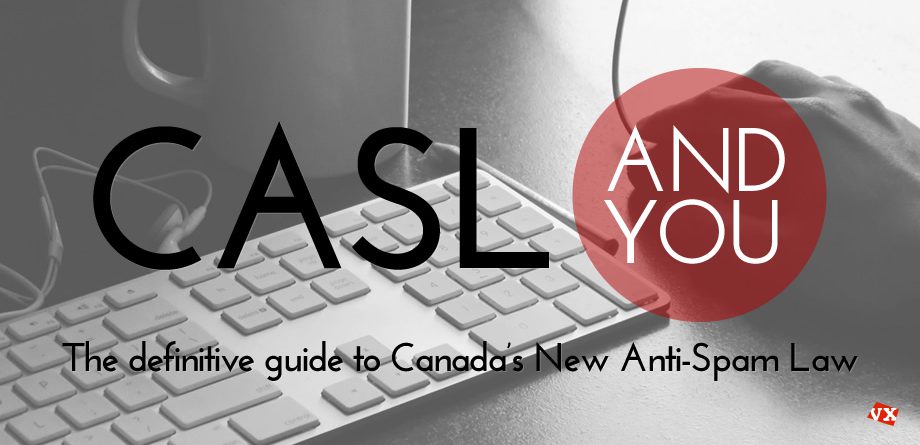There has been a lot of confusion and panic regarding the new “Canada’s Anti-Spam Legislation” (CASL) that came into effect on July 1, 2014. Before you panic, there is a 3-year transition period, but more on that later. Let’s start from the beginning…
Am I affected?
Easy, ask yourself two questions:
- Am I a business operating in Canada?
- Am I sending out commercial emails or texts?
Answer yes to both, and congrats, you’re affected!
How do I comply?
It is actually much more simple than you may think: Just follow these three rules:
1. Consent
You must have Implied or Express permission to be emailing or texting them. More on this below.
2. Identification
You must tell them who you are. Identify in the message your business name (or if you and the business share the same name, identify your name), and the name of any other business or people you are sending the email on their behalf.
Include:
- Name
- Mailing address
- One of:
- Phone number
- Email address
- Web address
Also, make sure they are valid for a minimum of 60 days after sending the message (no fly by night).
Sending an email newsletter? Put in the footer who you are and your website. Done.
3. Unsubscribe
Provide a way for the person receiving the email to unsubscribe, and without cost. Although the CRTC provides examples for this, the bottom line here is to make sure it is simple, quick and easy for the person to unsubscribe.
Implied Consent?
First of all, implied consent is time limited to generally 2 years from when the implied consent was given, or from the day the subscription or membership is ended.
According to CASL, implied consent is given when:
You have an existing business relationship
Don’t worry, you can still email anyone you are currently doing business with or have been doing business with within the last 2 years (see above).
Just make sure the recipient has made or enquired about:
- A purchase or lease of goods or services, land or interest in land.
- A written contract or the acceptance of a business, investment or gaming opportunity from you.
You do not have an existing business relationship, but…
You happen to be a registered charity, political party, or candidate and the person you are emailing you has given you a gift, donation or has done volunteer work for you; all within the last 2 years of course.
You are a club, association or voluntary organized and…
The person you are emailing is one of your current members, or has been within the last 2 years.
The email or cell phone number was given to you and…
Was openly given to you without any restrictions stated, and your message relates to the functions or activities of the person you are emailing, in a business or official way; within the last 2 years.
Express Consent?
The good one! Express consent is clearly the best option here, as there are no time limits to emailing them, unlike the generally 2 year restriction of implied consent.
How do you get it? Easy:
You have express written/oral consent to send them email
This can be obtained simply from a a checkbox on a website form, asking them if you can email them, or having them check a box in person that they explicitly want to receive email from you. There are a lot of ways to collect the consent, just make sure:
- You did not presume consent: the checkbox on your websites form was not “pre-checked”. Silence or inaction from the person is not the same as express consent.
- They gave you their business card and: you are only emailing them on subjects relating to their role, function or duty in a business or official way, AND they have not told you to not email them.
- You have proof (see Keeping Proof below).
Keeping Proof
You have to be able to show dated records that you had express or implied permission to send that email. In every case, the official word from CASL is:
In each case, the onus is on the person sending the message to prove that he/she has obtained consent to send the message.
Pretty vague don’t you think?
Proof for Express permission
You must be able to prove you collected their email through express consent means (see Express Consent above). Bottom line: keep everything. If they gave you their business card, keep it. Better yet, write when and where you received it on the back of it. If it was from a form on a website, and you use email software (ie. MailChimp, Constant Contact, etc.) hopefully it is keeping records for you.
Proof for Implied permission
This is the tough one. You have two years from when you last did business with them to email them. For most businesses this means that everytime you email them, you will have to check your records to see if it has been within two years. The good news? You have until June 31, 2016 to figure it out (two years from July 1, 2014 when this law came into place). Here’s hoping there is some software that will tie into most business accounting software for this.
More info
Official Source: fightspam.gc.ca
Official FAQ: http://fightspam.gc.ca/eic/site/030.nsf/eng/00304.html#q3
Video below:

